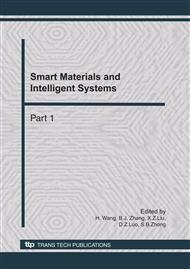[1]
AMBERG B., ROMDHANI S., VETTER T.: Optimal step nonrigid icp algorithms for surface registration. In Proceedings of IEEE CVPR (June 2009).
DOI: 10.1109/cvpr.2007.383165
Google Scholar
[2]
ALLEN B., CURLESS B., POPOVI´C Z.: The space of human body shapes: reconstruction and parameterization from range scans. ACM Trans. Graph. 22, 3 (2003).
DOI: 10.1145/882262.882311
Google Scholar
[3]
PAULY M., MITRA N. J., GIESEN J., GROSS M., GUIBAS L. J.: Example-based 3d scan completion. In Symposium on Geometry Processing (2007).
Google Scholar
[4]
BROWN B., RUSINKIEWICZ S.: Non-rigid range-scan alignment using thin-plate splines. In Symp. on 3D Data Processing, Visualization, and Transmission (2006).
DOI: 10.1109/tdpvt.2004.1335392
Google Scholar
[5]
GELFAND N., IKEMOTO L., RUSINKIEWICZ S., LEVOY M.: Geometrically stable sampling for the icp algorithm. In Proc. Int. Conf. on 3D Digital Imaging and Modeling (2005).
DOI: 10.1109/im.2003.1240258
Google Scholar
[6]
MADSEN K., NIELSEN H., TINGLEFF O.: Methods for Non-Linear Least Squares Problems. Tech. rep., Technical University of Denmark, (2006).
Google Scholar
[7]
BROWN B. J., RUSINKIEWICZ S.: Global non-rigid alignment of 3-d scans. ACM Trans. Graph. 26, 3 (2009), 21.
DOI: 10.1145/1276377.1276404
Google Scholar
[8]
WAND M., JENKE P., HUANG Q., BOKELOH M., GUIBAS L., SCHILLING A.: Reconstruction of deforming geometry from time-varying point clouds. In Symposium on Geometry processing (2009), pp.49-58.
Google Scholar
[9]
HARALICK R. M., STERNBERG S. R., ZHUANG X.: Image analysis using mathematical morphology. IEEE PAMI 9, 4 (1987), 532-550.
DOI: 10.1109/tpami.1987.4767941
Google Scholar
[10]
B. K. P. Horn, B. G. Schunk. Determing optical flow [J]. Artificial Intelligence, 1987. 17: 185-203.
Google Scholar
[11]
K. S. Arun, T. S Huang, S. D. Blostein. Least-squares fitting of two 3-D point sets[J]. IEEE Transactions on Pattern Analysis and Machine Intelligence, 1987. 9(5): 698-700.
DOI: 10.1109/tpami.1987.4767965
Google Scholar
[12]
Paul J. Besl, Neil D. McKay. A method for registration of 3-D shapes [J]. IEEE Transactions on Pattern Analysis and Machine Intelligence, 1992. 14(2): 239-256.
DOI: 10.1109/34.121791
Google Scholar
[13]
Y. Chen, G. Medioni. Object Modeling by Registration of Multiple Range Images [J]. Image and Vision Computing, 1992. 10: 145-155.
DOI: 10.1016/0262-8856(92)90066-c
Google Scholar
[14]
IKEMOTO L., GELFAND N., LEVOY M.: A hierarchical method for aligning warped meshes. In Proc. of 4th Int. Conference on 3D Digital Imaging and Modeling (2005).
DOI: 10.1109/im.2003.1240279
Google Scholar
[15]
WENDLAND H.: Scattered Data Approximation. Cambridge University Press, (2007).
Google Scholar
[16]
X. Sun, D. Gong. Interactive genetic algorithms with individual's fuzzy and stochastic fitness[J]. Chinese Journal of Electronics, 2009, 18(4): 619 - 624.
Google Scholar
[17]
Forsyth D A,Mundy J L,Zisserman A et al. Invariant descriptors for 3D object recognition and pose [J]. IEEE Transactions on Pattern Analysis and Machine Intelligence , 1991 , 13(10): 971~991.
DOI: 10.1109/34.99233
Google Scholar
[18]
V. Vapnik, S. E. Golowich, A. Smola. Support vector method for function approximation, regression estimation, and signal processing[C]/The 10th Annual Conference on Neural Information Processing Systems (NIPS). Cambridge: MIT Press, 1996: 281 - 287.
Google Scholar


